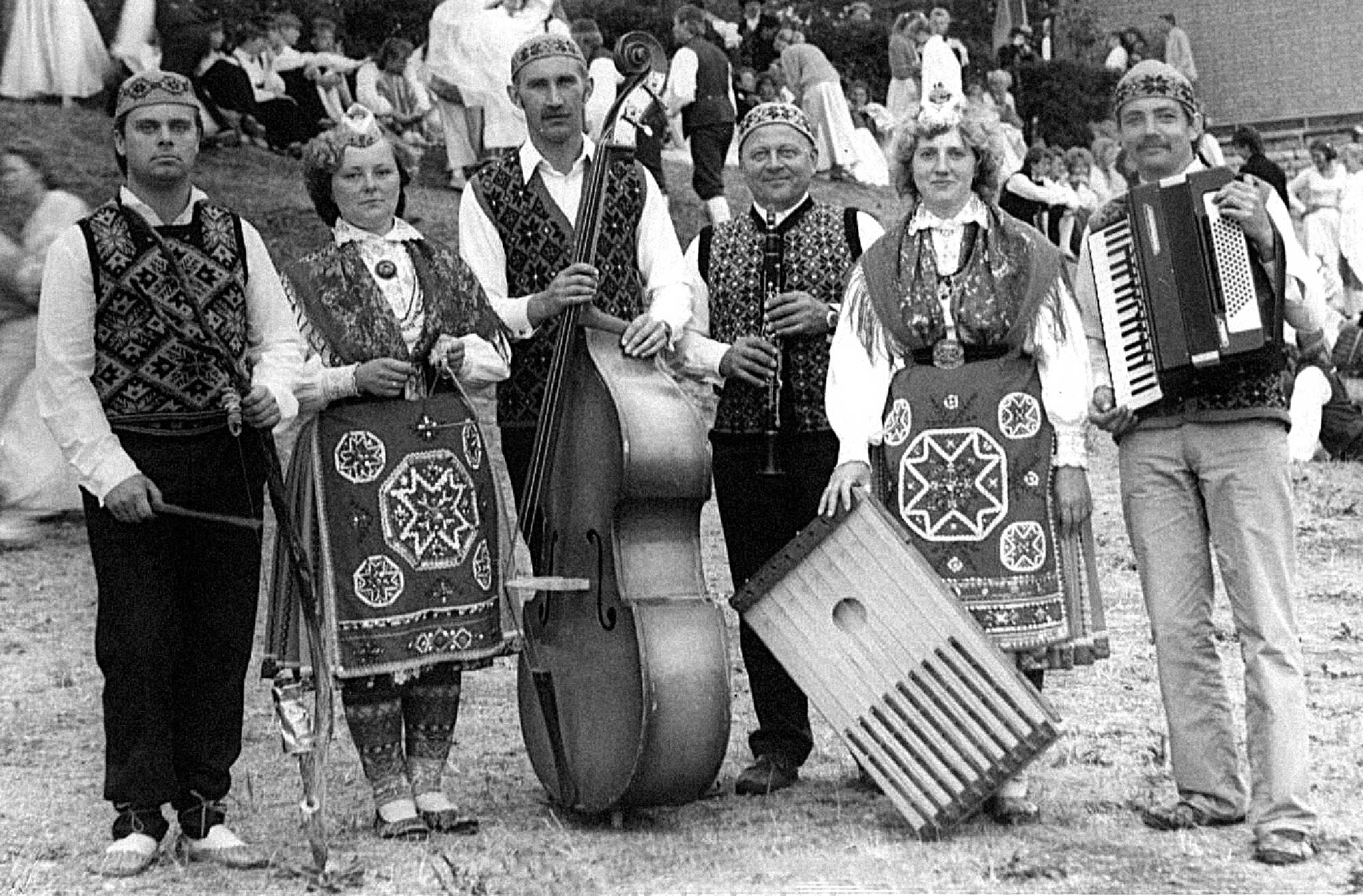Film “The Muhu islanders in the Kihnu festival” introduces the performance of the Muhu islanders during the Kihnu festival in 1994. The recordings have been made together with the Estonan TV film crew. The director was Ruti Murusalu and the cameraman was Rein Lillmaa. These recordings offer viewers the traditional culture in the present-day context, for here we can see an organized performance during a present-day festival. The event is an authentic Kihnu celebration with nothing staged especially for the filming. We can see traditional Muhu dances performed by the group “Ätses” who is accompanied by a singing and instrumental group “Laulusõbrad” that also performs some songs on their own. /---/
In addition to the folk songs well-known in Muhu the group performs the song “Kodusaar Muhu” (“Home island Muhu”). The author of this song is Arno Kask, who played in the national orchestra of conductors together with Vello Tikerpalu, the leader of the group “Laulusõbrad”. Having heard that Vello comes from Muhu, Arno Kask decided to present him with a song that “Laulusõbrad” included in their repertoire. The song “Muhu kalurivalss” (“The Muhu fisherman’s waltz”) is composed by a Muhu islander Vassili Kask who took part in the Liberation War and who has also been considered the author of songs “Kupu Kaarel” and “Muhulase noomitus” (“An admonition of a Muhu islander”). These songs tell of changes in the life of Muhu at the end of World War I and in the early years of independent Estonia. The author of the song “Two famous mills in the south of Muhu” (“The man of Vesiaa”) is a Muhu islander Mihkel Toom. The text of “Muhumaa” is by a Saaremaa islander Antonina Klaas with the tune composed by her husband Andres (Andrei) Klaas, a Russian Orthodox priest and choir conductor.

“Laulusõbrad” at a Dance Festival in 1990. L. Peegel’s private collection.
The dance group “Ätses” performs social dances which were popular in Muhu at the beginning of the 20th century. Apart from Muhu islanders the dance group of Viinistu civic centre was also invited to the Kihnu festival. The dancers came from the former Kuusalu parish. During the performance of the Muhu group they performed their versions of the same dances on the grass in front of the bandstand. This gives us an opportunity to compare different variants of the same dances. The Kihnu islanders also joined the waltz performed at the end of the event. It is noteworthy that differences of dancing style can be detected during spontaneous dancing (in the video “Song games in Suuremõisa village”) and in the performances.
Songs and dances:
Recorded by I. Rüütel, R. Murusalu, R. Lillma, E. Potter in 1994. Film FAV 256.
Editors Janika Oras, Kadi Sarv
Translation into English Inna Feldbach, Olga Ivaškevitš
Project co-ordinator Risto Järv
Web design Lorem Ipsum
Cover photo “Kuivastu Harbour in the early 20th century. Steamship “General Suvortsev” (on the left) and Muhu sailboat uisk (on the right)”. 1910–1919, Saaremaa Museum, SM F 3761:1514 F.
Published materials originate from following archives: Estonian Folklore Archives of Estonian Literary Museum, Estonian National Museum, Saaremaa Museum, Film Archives of National Archives and Estonian Film Institute.
We would like to thank the following contributors for their help in personal information specification: Mihkel Jürisson, Martin Kivisoo, Meelis and Marti Mereäär, Muhu Pärandikool, Helmut Noot, Airi Nõmm, Leena Peegel, Ago Rullingo, Irena Tarvis, Heiske Tuul, Tiiu Tuust, Kadri Tüür and Viia Väli.
Ensemble Trad.Attack!
Ministry of Education and Research (IUT22-4)
The European Union through the European Regional Development Fund (Centre of Excellence in Estonian Studies)
The Cultural Endowment of Estonia
ELM Scholarly Press, 2018
© and ℗ Estonian Literary Museum, 2018
© Ingrid Rüütel
ISBN 978-9949-586-77-6
[CD, DVD and textbook]
Sound production and CD mastering Jaan Tamm
DVD editing and mastering Jaan Kolberg
Editor Janika Oras
Translation into English Inna Feldbach
Language editors Olga Ivaškevitš, Kadri Tamm
Design Krista Saare
Print Kruul
Replication Baltic Disc AS
Editor Asta Niinemets
Music transcription Janika Oras, Ingrid Rüütel, Ludmilla Toon
Notation editing Ingrid Rüütel, Edna Tuvi
Sheet music graphics Edna Tuvi
Texts transcription Erna Tampere, Riina Rehe, Alviine Schmuul, Ingrid Rüütel
Dialectic texts editor Alviine Schmuul
Translation of summary Inna Feldbach
Layout and design Krista Saare
Print Greif